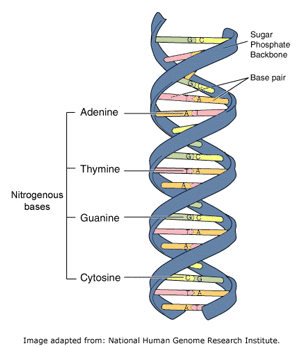Have you ever come across ‘DNA match’ while watching a Crime Series? Well, DNA is a type of Nucleic acid. Nucleic acids are biomolecules that are the building blocks of an organism. They are the information carriers within each cell, which basically transfer genetic material from one generation to the next. Interesting? Let’s find out more.
Suggested Videos:
What are the types of nucleic acids?
Nucleic acids are mainly of two types: DNA or Deoxyribonucleic acid and RNA or Ribonucleic acid. The other types of nucleic acids are tRNA, mRNA and rRNA.
What is the structure of these Nucleic Acids?
Nucleic acids are polymers which are made up monomer units called as nucleotides. Each nucleotide consists of three parts:

There are five nitrogen bases that are found in nucleic acids. Adenine, guanine, thiamin and cytosine are found in DNA, whereas, Adenine, guanine, uracil and cytosine are found in RNA. These nitrogen bases pair up very specifically and are held together by weak hydrogen bonds. Adenine always pairs up with thymine by two hydrogen bonds while guanine pairs up with cytosine with three hydrogen bonds.
Structure of DNA

DNA has a double-stranded structure helical structure formed from two polynucleotide chains. Each of these chains is also helical in nature. The two helical chains which intertwine with each other are held together by the hydrogen bonds between the paired nitrogen bases. When the two helical chains intertwine, the hydrophobic nitrogen bases are on the inside while the phosphate groups on the outside.This hydrogen bonding between complementary bases on each strand provides a mechanism for the DNA replication and transmission of genetic information. DNA is present only in eukaryotic animals.
Structure of RNA

(Source: Wikipedia)
Unlike DNA, RNA is a single-stranded nucleic acid polymer. It has four nucleotides namely adenine, guanine, cytosine and uracil. During the process of DNA replication, RNA is the first intermediary that is formed. Where DNA is quite stable and the ideal genetic material, RNA is reactive in nature and is sensitive to oxidising agents. In DNA, the complementary base pairing occurs between both the strands but in RNA, the base pairing occurs with bases within the same strand. RNA is found as the genetic material in prokaryotes.
RNA are of different types depending upon their function:
- Messenger RNA(mRNA): It helps to transfer the genetic information from the genes on the DNA to the ribosomes.
- Ribosomal RNA(rRNA): This RNA forms the structural components of the ribosome. They play an active role in recognizing conserved portions of mRNAs and tRNAs. They also assist with the catalysis of protein synthesis. In eukaryotes, rRNA genes are looped out of the main chromosomal fibres and coalesce in the presence of proteins to form a cell organelle called the nucleolus. The nucleolus is where the rRNA genes are transcribed and the early assembly of ribosomes takes place.
- Transfer RNA( tRNA): t-RNA help to transfer amino acid residues from amino acid pool to the site of proteins synthesis i.e ribosomes. Specific tRNAs exist for each of the 20 amino acids that needed for protein synthesis. In a few cases, more than one tRNA for each amino acid is present.
Solved Example for You
Q: Which nitrogen base pairs up with Adenine?
a. Guanine
b. Thiamin
c. Uracil
d. Both b and c
Sol: d. Both b and c
Adenine pairs with both thiamin and uracil. Adenine forms two hydrogen bonds with thiamin in DNA and with uracil in RNA. So, the correct answer is option d.






DNA consists of thymine or thiamine??